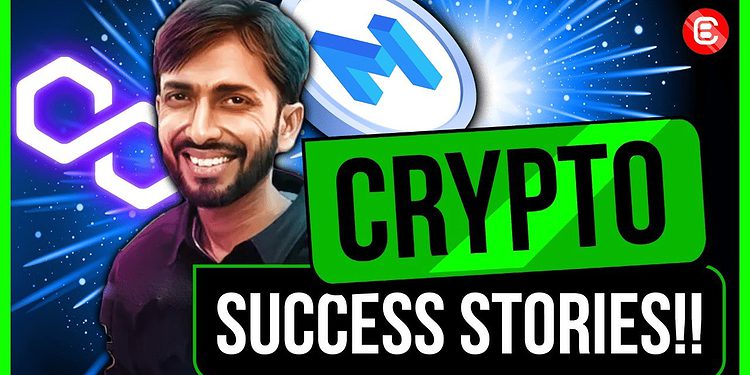In a recent Twitter thread, Shreyans Singh gave an overview of the remarkable story of Jaynti Kanami, and it was so inspiring that we thought it would be the perfect start of a series we’ve been looking forward to getting started on: Crypto Banter’s top blockchain success stories. Thanks to Shreyans for the great thread – give the guy a follow, he posts fantastic stories from the crypto space. Banter Fam, you know what to do!
Jaynti’s humble beginnings
Jaynti Kanami grew up in Gujarat, the son of a diamond-factory worker. And he ended up founding a little crypto start-up called Polygon. Today, there isn’t a single crypto enthusiast who hasn’t heard of Polygon, the leading Ethereum Layer-2 solution (or even a Layer-1 of its own). And its $11 billion valuation speaks for itself.
But it wasn’t always so.
Let’s follow Jaynti Kanami’s story, courtesy of Shreyan’s excellent thread.
Jaynti Kanami – The early days
Jaynti Kanami grew up surrounded by poverty on the outskirts of Ahmedabad.
He was the son of a diamond-factory worker, and the family income could only afford a small house for them to live in. Even then, things were tight. So much so, that his father had to take out a loan in order to pay for Jaynti’s school fees.
Then, tragedy struck when Jaynti’s father became ill and started to lose his vision, forcing him out of work.
Despite the unfateful events, Jaynti powered through and secured a spot at Dharamsinh Desai University, in Nadiad, where he studied engineering. It was there that he set himself a goal: to get a job that would allow him to pay off his father’s debt. On graduation, he went about applying to major tech companies, such as Twitter. Unfortunately, talent is not always recognized, and Jaynti’s applications were continually rejected.
Building a career
He did eventually land a job, but hardly enough to meet his goals, since it paid the princely sum of 6,000 rupees per month: at today’s rate, that’s approximately $77. However, his prospects seemed to improve when he landed a role at a data science company in Houston. Working for others, he realized, was not his dream. He sought to do something about it.
Jaynti created a unique betting website. Unique because of its specificity: namely, it allowed users to bet on which Game of Thrones’s character would be the next killed off!
The process of building the platform required him to navigate India’s financial rules and regulations, overcoming a range of legal hurdles before being able to add in the payment feature to his site.
This led him to look for alternative payment methods, which, you guessed it, led him to crypto.
Discovering crypto
It didn’t take Jaynti long to discover Ethereum (which was under a lot of stress at the time). As a result of its runaway popularity, the decentralized app (dApp) CryptoKitties was congesting the Ethereum network, driving up Ethereum’s gas fees and making the network slow and expensive. How little has changed!
Jaynti resolved to do something about it, something that could make Ethereum faster, and cheaper to use.
So, he started working on a solution, developing this idea with his friends, Sandeep Nailwal and Anurag Arjun, and later, with Mihalio Jelic.
The birth of the Layer-2
And so, Polygon was formed (though at the time it was known as the Matic network). Unfortunately, crypto was enduring a bear market and investors were reluctant to fund the project. Jaynti and his colleagues struggled, but managed to scrape together some capital courtesy of friends and family until, in 2019, things took a turn for the better, thanks to Binance’s Initial Exchange Offering of $5m.
Not only was the money a game-changer, but it gave the team the exposure it needed. Developers were frustrated by Ethereum’s slow speed, and were astonished to see just the kind of performance the Matic network could offer, being as much as 4,000 times faster and 10,000 times cheaper than Ethereum itself. Such low prices may not have lasted, but it remains a fraction of the insane gas fees we’re accustomed to the Layer-1!
As a result, a range of top-tier projects began building on Matic, including OpenSea and Decentraland, whilst at the same time, major investors, including Mark Cuban, came on board to continue funding it.
The rise of Polygon
Anyone who was around in early 2021 will remember the insane run the MATIC token went on, shortly after its rebrand to Polygon on February 9th, 2021.
Today, Polygon is a titan, one of the major players in the crypto ecosystem, a top 20 project by marketcap, with over 135 million users, and a valuation of $11 billion. Even though it acts as a Layer-2 solution for Ethereum, many believe that, after Ethereum’s 2.0 network upgrade, it will stand tall as a de facto Layer-1 of its own.
Banter’s take
Only in crypto can a project gain so much traction in so little time, and Polygon is a prime example. Only 18 months ago, few in the space were aware of its existence. Today, you’d be hard pushed to find a serious crypto person who hasn’t used the network, or at the very least, held the token! Jaynti hasn’t just achieved his goal, he’s blown it out the water, quickly emerging as one of the most impressive project leaders in the space. His team’s rise has been nothing short of parabolic, and long may it continue.






